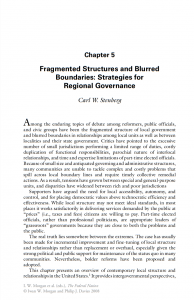
Among the enduring topics of debate among reformers, public officials, and civic groups have been the fragmented structure of local government and blurred boundaries in relationships among local units as well as between localities and their state government. Critics have pointed to the excessive number of small jurisdictions performing a limited range of duties, costly duplication of functional responsibilities, parochial nature of interlocal relationships, and time and expertise limitations of part-time elected officials. Because of small size and antiquated governing and administrative structures, many communities are unable to tackle complex and costly problems that spill across local boundary lines and require timely collective remedial actions. As a result, tensions have grown between special and general-purpose units, and disparities have widened between rich and poor jurisdictions Supporters have argued the need for local accessibility, autonomy, and control, and for placing democratic values above technocratic efficiency and effectiveness. While local structure may not meet ideal standards, in most places it works satisfactorily in delivering services demanded by the public at “prices” (i.e., taxes and fees) citizens are willing to pay. Part-time elected officials, rather than professional politicians, are appropriate leaders of “grassroots” governments because they are close to both the problems and the public.
Cite as:
Stenberg C.W. (2008) Fragmented Structures and Blurred Boundaries: Strategies for Regional Governance. In: Morgan I.W., Davies P.J. (eds) The Federal Nation. Studies of the Americas. Palgrave Macmillan, New York
Download file
Carl Stenberg
Local Government Management

